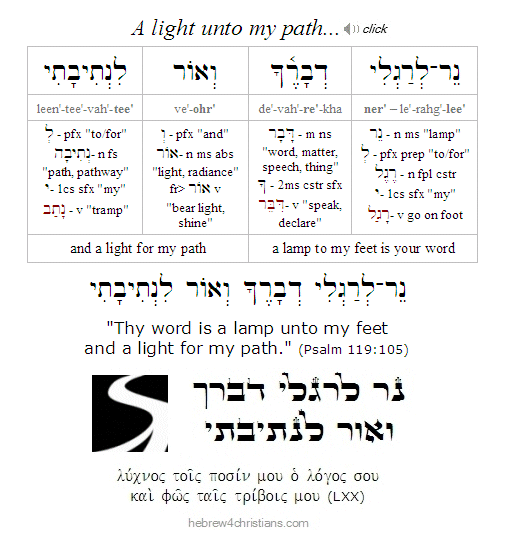|
The holy menorah (מְנוֹרָה) was formed from one piece of pure beaten gold weighing 3,000 shekels of silver (nearly 100 pounds). It was a highly decorative work that had seven branches (with seven lamps), nine flower blooms, eleven fruits, and twenty two cups. The light from the Menorah was a spiritual light. It was not seen from the outside of the Tabernacle, but only while inside the holy chamber, before the holy place of sacrificial atonement. It enabled service to God to be performed, though it was not a light to be used for profane purposes. Notice that the six lamps faced the central lamp -- a picture of Yeshua, the Light of the World whose arms and legs were "hammered" for our sins.... He is the suffering servant (shamash) who lightens everyone in the world. He is the center, the supporting trunk for the other branches (John 15:5).
The physical light came from the burning of pure olive oil - a symbol of anointing and the Holy Spirit (רוּחַ הַקּדֶשׁ). It was kindled by the hand of a man of peace and humility. Likewise, when we are given light to behold the sacrifice of Yeshua for our atonement (כַּפָּרָה), we are filled with the divine light (John 8:12; 1 John 1:7, Eph. 5:8). When we come to the cross, we can behold the truth of God's unfailing love that draws us to be united with Him.
Interestingly, the Ark of the Covenant was kept in complete darkness, since not even the light of the Menorah could penetrate the innermost chamber (i.e., Holy of Holies). "The darkness and the light are both alike unto Thee" (Psalm 139:12). It was only after the parochet was torn asunder that access was made to the "thick darkness of the Cloud," that is, to the very Throne of Grace, for all who will come in faith (Heb. 4:16).
נֵר־לְרַגְלִי דְבָרֶךָ
וְאוֹר לִנְתִיבָתִי
ner-le·rag·lee · de·vah·re'·kha
ve·ohr · leen·tee·vah·tee

"Thy word is a lamp unto my feet
and a light for my path."
(Psalm 119:105)

Hebrew Lesson:
Psalm 119:105 Hebrew reading:
Most of the beauty of the Mishkan (Tabernacle) was only seen during the priestly service. Regarding the Ark of the Covenant, the aron hakodesh (אֲרוֹן־הַקּדֶשׁ), the Torah states: "You shall overlay it with pure gold, inside and outside shall you overlay it, and you shall make on it a molding of gold around it" (Exod. 25:11). The Gemara (Yoma 72b) says that the ark was the same on the outside as it was on the inside to teach us that our "outside" must match our "inside," or as it is stated there: "Any disciple whose inside is not as his outside is not a true disciple." In Jewish ethical thought, this is called tocho kevaro (תּוֹכוֹ כְּבָרוֹ), the "inside as outside" principle, which means that our lives should be straightforward and free from inner duplicity. In other words, we should be "golden" both inside and out, and that our actions should match the hidden intentions of our heart.
|




